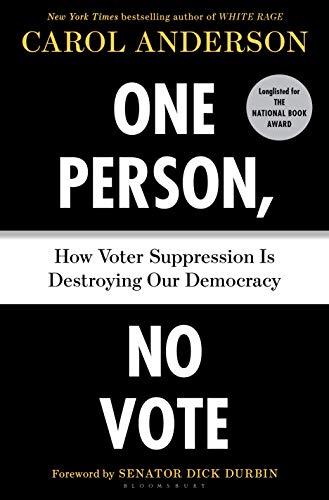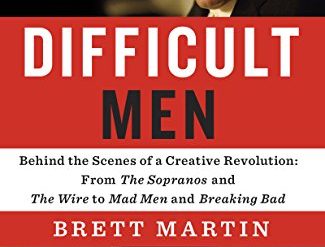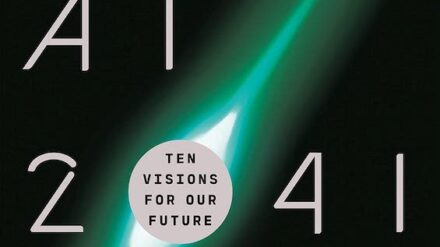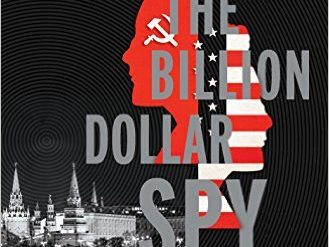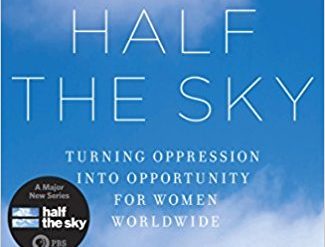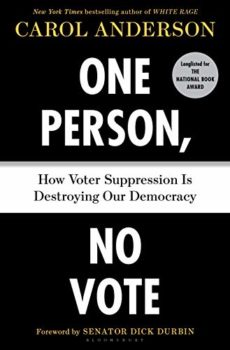
Democrats tend to act as though the greatest harm that results from all the recent monkeying around with voter registration and election mechanics is that the Republican Party gains an unfair advantage. That’s true, of course, as far as it goes. But what is often lost in the debate about voter suppression, gerrymandering, and voter ID laws is that they disproportionately disenfranchise African-Americans and other people of color. The reality is that these widely employed Republican tactics are reminiscent of the Jim Crow laws of the 19th and 20th centuries. And that’s the underlying theme of Professor Carol Anderson’s trenchant new book, One Person, No Vote: How Voter Suppression Is Destroying Our Democracy.
Estimated reading time: 5 minutes
“The central issue of racial justice in our time: the right to vote”
News reports about voter suppression, gerrymandering, and voter ID laws often give the impression that only a handful of states are affected. This is absolutely untrue. One article may focus on events in North Carolina, another on Wisconsin or Texas. But the pattern is pervasive. “In 2017,” Anderson notes, quoting an article by Ari Berman in The Nation, “’99 bills to limit access to the ballot have been introduced in 31 states . . . and more states have enacted new voting restrictions in 2017 than in 2016 and 2015 combined.'”
These tactics indisputably represent a nationwide Republican strategy designed to mitigate the effects of their party’s growing demographic disadvantage as people of color steadily approach a majority of the nation’s population. And the impact of these tactics is substantial. Professor Anderson cites studies that show how lowered turnout in African-American and Latino communities undoubtedly played a part in Donald Trump’s election in 2016.
One Person No Vote: How Voter Suppression Is Destroying Our Democracy by Carol Anderson (2018) 280 pages ★★★★★
How Republicans steal elections today: voter suppression, gerrymandering, and voter ID laws
In One Person, No Vote, Anderson briefly surveys the history of voting rights in America. However, unlike many other treatments of the subject, she explains exactly how the laws and practices that constituted Jim Crow resulted in dramatically limiting African-American voter participation. Of course, Jim Crow was avowedly, belligerently racist. The poll tax, “literacy” tests, the white primary, and other tactics were explicitly designed to keep black people from voting.
Today, by analogy, we have voter suppression, gerrymandering, voter ID laws, voter roll purges, limiting access to polling places, denying felons the right to vote, and other nefarious tactics. These techniques are not overtly racist. But the effect is similar—and so too, all too often, is the motivation. The upshot is that people of color aren’t the only ones to suffer. All of us Americans are paying the price, as we watch the integrity of our democratic system gradually slip into the mists of history.
Naturally, this pattern is not solely the doing of the institutional Republican Party. The courts, including the United States Supreme Court, have played a crucial role as well, most egregiously in undermining the Voting Rights Act. So-called “conservative” judges defer to states’ rights and the Founding Fathers’ alleged intentions when it is convenient for them to do so. (If these “conservatives” are conserving anything, it’s not democracy.)
“North Carolina is no longer a fully functioning democracy”
“In 2016,” Anderson writes, “the Economist Intelligence Unit, which had evaluated 167 nations on sixty different indicators, reported that the United States had slipped into the category of a ‘flawed democracy’ . . . Similarly, the Electoral Integrity Project . . . was stunned to find that when it applied [the same] calculations in the United States it had in Egypt, Yemen, and Sudan, North Carolina was ‘no longer considered to be a fully functioning democracy.’ Indeed, if it were an independent nation, the state would rank somewhere between Iran and Venezuela.”
One major theme is missing from this book
By focusing on voter suppression, gerrymandering, and voter ID laws, Professor Anderson avoids an equally consequential flaw in American democracy: the rural-urban split built into the Constitution. Each state, no matter how small its population, seats two United States Senators, thus conferring a huge advantage on small, predominantly rural states. And the Electoral College reinforces that advantage by enabling presidential candidates to win election even if they fail to capture a majority of the votes cast.
In a seminar I attended recently sponsored by the New York Times, political scientist Norman Ornstein of the conservative think tank, American Enterprise Institute, revealed that by 2040, 70 percent of the American population will live in 15 states. Thus, 30 percent of the people will elect 70 percent of the Senate. The population ratio of the biggest to the smallest state is 70:1 today, he noted. Does this sound like democracy to you? It doesn’t to me.
About the author
Professor Carol Anderson chairs the African-American Studies department at Emory University. She is the author of White Rage (2016), a New York Times bestseller that explores how the legacy of structural racism has led to white anger and resentment. The book was widely read, and widely praised, for its contribution to the debate about the dynamics of the 2016 Presidential election.
For related reading
I’ve also reviewed a similar book, The Hidden History of the War on Voting: Who Stole Your Vote — and How to Get It Back by Thom Hartmann. You’ll find my review at The Republican war on voting unmasked.
- You might also be interested in:
- Good books about racism reviewed on this site
- Top 10 nonfiction books about politics
- Top 20 popular books for understanding American history
- 10 enlightening books about poverty in America
And you can always find my most popular reviews, and the most recent ones, on the Home Page.

